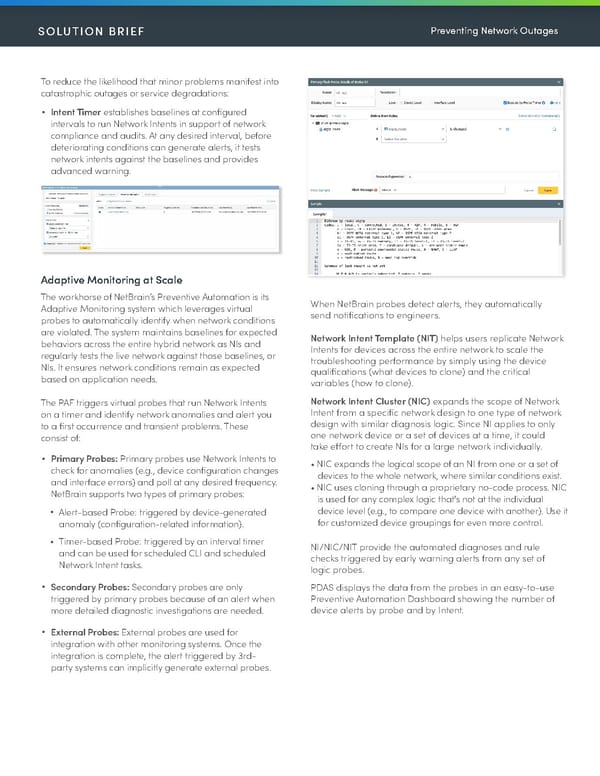SOLUTION BRIEF Preventing Network Outages To reduce the likelihood that minor problems manifest into catastrophic outages or service degradations: Adaptive Monitoring at Scale The workhorse of NetBrain’s Preventive Automation is its Adaptive Monitoring system which leverages virtual probes to automatically identify when network conditions are violated. The system maintains baselines for expected behaviors across the entire hybrid network as NIs and regularly tests the live network against those baselines, or NIs. It ensures network conditions remain as expected based on application needs. The PAF triggers virtual probes that run Network Intents on a timer and identify network anomalies and alert you to a first occurrence and transient problems. These consist of: When NetBrain probes detect alerts, they automatically send notifications to engineers. Network Intent Template (NIT) helps users replicate Network Intents for devices across the entire network to scale the troubleshooting performance by simply using the device qualifications (what devices to clone) and the critical variables (how to clone). Network Intent Cluster (NIC) expands the scope of Network Intent from a specific network design to one type of network design with similar diagnosis logic. Since NI applies to only one network device or a set of devices at a time, it could take effort to create NIs for a large network individually. NI/NIC/NIT provide the automated diagnoses and rule checks triggered by early warning alerts from any set of logic probes. PDAS displays the data from the probes in an easy-to-use Preventive Automation Dashboard showing the number of device alerts by probe and by Intent. • NIC expands the logical scope of an NI from one or a set of devices to the whole network, where similar conditions exist. • NIC uses cloning through a proprietary no-code process. NIC is used for any complex logic that's not at the individual device level (e.g., to compare one device with another). Use it for customized device groupings for even more control. • • Primary Probes: Primary probes use Network Intents to check for anomalies (e.g., device configuration changes and interface errors) and poll at any desired frequency. NetBrain supports two types of primary probes: • Secondary Probes: Secondary probes are only triggered by primary probes because of an alert when more detailed diagnostic investigations are needed. • External Probes: External probes are used for integration with other monitoring systems. Once the integration is complete, the alert triggered by 3rd- party systems can implicitly generate external probes. • • Alert-based Probe: triggered by device-generated anomaly (configuration-related information). Timer-based Probe: triggered by an interval timer and can be used for scheduled CLI and scheduled Network Intent tasks. Intent Timer establishes baselines at configured intervals to run Network Intents in support of network compliance and audits. At any desired interval, before deteriorating conditions can generate alerts, it tests network intents against the baselines and provides advanced warning.
 NetBrain Preventing Network Outages Solution Brief_11-7-22 Page 2 Page 4
NetBrain Preventing Network Outages Solution Brief_11-7-22 Page 2 Page 4